Intercontinental Exchange, Inc. (NYSE:ICE), a leading operator of global exchanges and clearing houses and provider of data and listings services, launched nine more Marine Fuel 0.5% futures contracts ahead of 0.5% sulphur cap by the International Maritime Organization (IMO) in January 2020, reports Business Wire.
New futures contracts
Initially ICE launched Marine Fuel contracts launched in February 2019. These new futures contracts expand the existing suite and will settle against the S&P Global Platts physical Marine Fuel 0.5% assessments.
The IMO regulation limits sulphur emissions from shipping bunker fuel, requiring ships to use fuel oil with a maximum sulphur content of 0.5% outside designated emission control areas.
Marine Fuel complex growth
Since launching in February 2019, the Marine Fuel complex has grown to approximately 18.7 million barrels-equivalent open interest as of July 25, 2019 with approximately 30.9 million barrels trading since the contracts launched.
The contracts added to existing suite
The new contracts are as follows:
- Fuel Oil Diff – Marine Fuel 0.5% FOB Rotterdam Barges (Platts) vs Fuel Oil 1% FOB NWE Cargoes (Platts) Future
- Fuel Oil Outright – Marine Fuel 0.5% FOB Rotterdam Barges (Platts) Balmo Future
- Fuel Oil Outright – Marine Fuel 0.5% FOB Rotterdam Barges (Platts) Mini Future
- Fuel Oil Outright – Marine Fuel 0.5% FOB Rotterdam Barges (Platts) Average Price Option
- Fuel Oil Outright – Marine Fuel 0.5% FOB Singapore (Platts) Balmo Future
- Fuel Oil Outright – Marine Fuel 0.5% FOB Singapore (Platts) Mini Future
- Fuel Oil Outright – Marine Fuel 0.5% FOB Singapore (Platts) Average Price Option
- Gasoil Diff – Gasoil 0.1% FOB ARA Barges (Platts) vs Marine Fuel 0.5% FOB Rotterdam Barges (Platts) Future
- Gasoil Diff – Low Sulphur Gasoil 1st Line vs Marine Fuel 0.5% FOB Rotterdam Barges (Platts) Future
Contracts used to manage price exposure
“We’re seeing rapidly growing demand for our Marine Fuel futures contracts and increasing liquidity as market participants use these contracts to manage their price exposure in advance of IMO 2020,” said Jeff Barbuto, Vice President of Oil Markets at ICE.
“These new contracts include Marine Fuel mini-contracts which will help shipping companies looking for smaller-size contracts to manage their risk. Blending and refining spreads can be hedged using the newly listed differential contracts based on the price difference between Gasoil and Marine Fuel.”
Go-to price marker
The ICE marine fuel complex operates alongside ICE’s deeply liquid benchmark Low Sulphur Gasoil, fuel oil and LNG markets, providing customers with a range of hedging tools to assist them with the transition to the IMO regulations in 2020.
ICE Low Sulphur Gasoil is the key global refined oil benchmark. The contract has become the go-to price marker for the middle part of the refined barrel and the world’s leading middle distillate benchmark.
ICE Low Sulphur Gasoil is an important and efficient hedging and trading mechanism, providing market participants with access to a range of products in a single contract and plays the same role for middle distillate oil that ICE Brent Crude plays for the crude oil market.
Trade based on ICE markets
Half of the world’s crude and refined oil futures are traded on ICE’s markets, including:
- futures and options on the global benchmark ICE Brent,
- the U.S. benchmark West Texas Intermediate (WTI) crude,
- ICE Permian WTI,
- the Asian benchmark Platts Dubai crude,
- Heating Oil and RBOB Gasoline, as well as more than 500 additional grades and oil products.
Did you subscribe to our daily newsletter?
It’s Free! Click here to Subscribe!
Source: BusinessWire



























